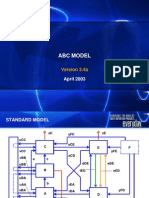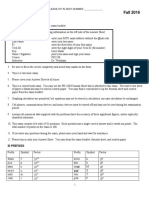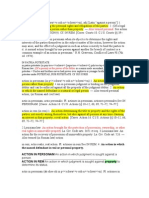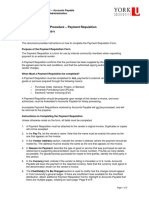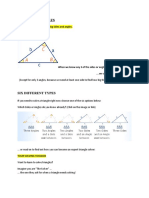Black Box
Black Box
Uploaded by
Anonymous L21MIUqACopyright:
Available Formats
Black Box
Black Box
Uploaded by
Anonymous L21MIUqAOriginal Description:
Copyright
Available Formats
Share this document
Did you find this document useful?
Is this content inappropriate?
Copyright:
Available Formats
Black Box
Black Box
Uploaded by
Anonymous L21MIUqACopyright:
Available Formats
EE2112 Circuit II Lab
Experiment 8: Blackbox Testing
1 Introduction and Objectives
For this lab you will use all of the knowledge you have acquired in your circuits courses to test an
actual black-box with a unknown passive circuit configuration inside. These unknown black-boxes
are going to be either a first or second order system, consisting of combination of one resistor, one
inductor, and/or one capacitor. You will exercise your critical thinking skills to ascertain what the
configuration and values on the unknown black-box circuit.
Note 1: No hand written assignments submission will be accepted. Create a tem-
plate inside a Microsoft word document (or other word processing software) like the
sample template provided for you for Lab 01 and answer questions in this document.
Note 2: Laboratory TA’s have primary responsibility to check your final results. You
must get your laboratory instructor(TA)’s signature for any part of lab’s short form
report during lab/open lab time if it is required. If your lab has “Laboratory Helper”,
do not ask Lab helper to give you laboratory instructor approval.
2 Pre-lab Assignment
Everything for submission in this lab will be done on the canvas page. For the prelab assignment
each person writes and submits an individual and unique short form report including student
name,lab section and TA name. It must be submitted on the canvas course page in the pre lab
assignment BEFORE your appropriate lab section starts. Use appropriate software (word, excel,
. . . ) to create the same template like the prelab template at the end of lab manual 1 and perform
the following inside of created word file document.
Figure 1: Prelab Circuit for Testing
EE2112 Circuit II Lab Experiment 8: Blackbox Testing
Prepare and submit a test proposal document that fully describes a set of tests that will reveal the
exact nature of the circuit within the black box. In your report describe how your testing process
will be applied to the circuit in Fig. 1 using Multisim. Implement your method to the circuit
and discussed (using Figures, Equations, citations, and referencing) how you can obtain the circuit
configuration and the values describe your methods. You specifically need to address the below
points.
1. Discuss how you will used the measurements device in lab oscilloscopes, Digital Multimeters,
etc. (NO LRC METERS SHOULD BE USED) to find the configuration of the circuit.
2. Show the calculations (with numerics) used to derive the parameters based on measured data.
3. Upload your proposal and any simulation file(s) you created showing how you obtain the
values from the measurement devices.
3 Concept and Background
Product design benchmarking is a term that is very common in the engineering field. It involves
obtaining a product and “reverse engineering” how the product was designed by using a series of
tests and probing steps. This can also be refered to as black box testing. Black box testing is a
software testing term used to describe testing a piece of code for functionality with no knowledge
of how the internal code is organized or written. The tester only knows what the code does, not
how it is written. Your company, GEA Circuit Enterprises, has developed a first or second order
system box that they wish for you to test their companies design against another top seller in the
market. Figure 2 demonstrates the black box image and port arrangement.
Figure 2: Two Port Network with Unknown Elements
An RLC circuit is an electrical circuit consisting of capacitor (C), a resistor (R) and an inductor
(L) connected in parallel, series, or series/parallel. You will need to use the concepts taught in
both of the circuits course to develop a test plan, execute that test plan, and find out what is the
circuit configuration, along with its values. For all circuits, the connector labeled 2 and 4 will be
Rev. November 7, 2017 Michigan Technological University Page 2 of 6
EE2112 Circuit II Lab Experiment 8: Blackbox Testing
connected together as shown in Fig. 1. No elements will be connected on a diagonal, either from
connector 1 to 4 or connector 2 to 3.
In order to develop your testing method/proposal you will need to you should draw from your
knowledge of Circuits I and II lecture material, as well as your prior Circuits II lab practical know.
These topics and concepts include:
• Resistive measurements.
• Steady-State Inductor/Capacitor behavior.
• First and Second order response: time constant, natural frequency, damping ratio, etc...
• Voltage and/or current measurements using a multimeter and oscilloscope.
4 Procedure
Form groups of 2 or less and complete the tasks for this lab experiment are as follows:
1. Prepare and submit a test proposal that fully describes a set of tests that will reveal the exact
nature of the circuit within the black box.
2. After your test proposal is approved by your TA, conduct your examination and report your
findings in the form of a schematic drawing of the circuit.
3. After you have conducted your test, prepare a presentation on your methods for testing and
how your arrived at the circuit configuration and values.
4. After your have conducted your test, prepare a report on your testing methods, the circuit
configuration and values.
You will work in teams to design a set of tests that will enable you to precisely describe the
circuits contained in the devices. This Test Proposal must be submitted to your TA and approved
BEFORE you conduct your tests. Please include a detailed, step-by-step description of all proposed
test methods including equipment required, connections to be made to the device under test, signal
inputs, and the expected results of the test. Also, include decision trees, drawings and schematics
as necessary to fully illustrate your test proposal. Each team will submit a test proposal to their
TA not later than one-week after the device is received. You will not be allowed to proceed to the
next step in the process until you have received an approved Test Proposal from your TA. This
may take several attempts. Your TA will provide you with feedback to guide your efforts. See the
attached process diagram Fig. 3 for more information.
Rev. November 7, 2017 Michigan Technological University Page 3 of 6
EE2112 Circuit II Lab Experiment 8: Blackbox Testing
Receive Develop Test Proposal Approved Conduct Draft Deliver Report
Blackbox Repeat Report
Proposal Review Proposal Test & Presentation
Figure 3: Process Flow Chart
You will need to follow the below safety Notes and Restrictions:
• Only a digtial multi-meter and/or an oscilloscope may be used to test the ports of the box.
(NO LRC METERS SHOULD BE USED)
• DO NOT attempt to open the case on your test device. All examinations of these devices
must be performed without exposing the contents.
• DO NOT apply more than 10 Vdc or 10 Vrms across any terminal of the device.
• DO NOT remove the black box from the EE2112 lab.
After you receive your approved Test Proposal from your TA, conduct the tests according to the
procedures developed in the Test Proposal. Report your conclusions about the exact nature of
the circuit, including circuit topology and component characteristics in standard lab report format
prescribed by department policy. Include drawings, schematics and an assessment of your confidence
in the precision of your findings. Your report will be deliverable before the end of the semester. Be
prepared to present your findings (5-10 minutes) to a panel of distinguished researchers after your
report is delivered. All reports and assignments must be completed by the listed due dates of the
Canvas assignment.
Rev. November 7, 2017 Michigan Technological University Page 4 of 6
EE2112 Circuit II Lab Experiment 8: Blackbox Testing
5 Laboratory Post Lab Report
For this report the group will submit report detail how the group researched, derived, developed,
implemented, tested, and arrived at the file conclusions. Everyone in the group is expected to
equally contribute to the writing, reviewing, and accuracy of the data/findings. Using the data
obtained in the lab, prepare a report using the following guidelines. Be sure to use proper format,
as dictated by the lab website.
• Objective : Briefly describe what was this lab about.
• Procedure : The procedure consists of a past-tense paragraph format retelling of what you
did for the lab, and what you used. It should be reasonably detailed, but not overly so. It
should include a detailed, step-by-step description of all proposed tests including equipment
required, connections to be made to the device under test, signal inputs, and the expected
results of the test.
• Discussion : Discuss about the method and procedures you apply to derive the internal
schematic of box. Show all your calculation. Also, include decision trees, drawings and
schematics needed for the discussion.
• Conclusion : Summarize all results (numerically and what they looked like), and tell whether
they compared to theory, and why or why not. And summarize what was learned.
Note that your report’s main structure should be included:
• Includes cover page, table of contents, table of figures, tables of tables, student name,TA
name, section name, objective, procedure, discussion, conclusion, references, appendix.
• Cite any sources(at least three sources) you use for your report.
• Generally use past tense when describing what was done or what was observed. You can use
present tense when talking about theory. Use passive verbs rather than active (i.e. ”The
circuit was constructed” rather than ”I constructed the circuit”). Avoid using ”I,” ”me,”
etc., as this is an academic and industry standard.
• Put figures on the first page on which you reference them. Only put results in the discussion
and conclusion, not in the objective and procedure.
• Put all data / excel files in appendix part and report their plots in discussion part.
Rev. November 7, 2017 Michigan Technological University Page 5 of 6
EE2112 Circuit II Lab Experiment 8: Blackbox Testing
6 Post Laboratory Presentation
Each group of students should present their work in lab via a 10-15 minute presentation and
submit their presentation files on canvas as a group. Using the data obtained in the lab, prepare a
presentation in Microsoft power point using the following guidelines. Be sure to use proper format,
as dictated by the lab web site. Structuring the body of a presentation should begin with giving
some critical thought about the goals are for the experiment. The following structure is a good
basic general model for a presentations:
• Begin by introducing yourself(s) and/or team.
• Introduce your presentation and outline what is to come.
• Present your main points in a logical order.
• Summarize the main points succinctly and clearly.
• Make final comments.
• Invite audience to ask questions
For your presentation you need to provide the following details:
• Beginning: Tell about the problem and why your experiment is an important one - provide
context. You should give the key ideas that you covered in the presentation as a way of brief
review of outline for your audience.
• Middle: Explain how you did your experiments and what was found. The main structural
strength of this presentation is your ability to highlight the most important pieces of informa-
tion that the audience should know in order to understand the main goal of your experiment.
• End: Summarize it all, tell what it means, did you meet goals, what are your recommenda-
tions for future work in this area?
Do not forgot time management is one important task in presentation. Organize your presentation
based on allocated time and practice several time before you final presentation.
Rev. November 7, 2017 Michigan Technological University Page 6 of 6
You might also like
- ABC ModelDocument39 pagesABC Modelamorantonio2No ratings yet
- The Economics of Money, Banking, and Financial Markets: Seventh Canadian EditionDocument52 pagesThe Economics of Money, Banking, and Financial Markets: Seventh Canadian Editionsantiago maciasNo ratings yet
- Health Unit: Social and Consumer Health Section: Government Agencies Activity: Federal AgenciesDocument2 pagesHealth Unit: Social and Consumer Health Section: Government Agencies Activity: Federal AgenciesShannon White40% (5)
- LAW NO. 489 ORGANIC LAW OF THE CENTRAL BANK OF PARAGUAY, AMENDED AS OF 1997 - Translated by IMFDocument32 pagesLAW NO. 489 ORGANIC LAW OF THE CENTRAL BANK OF PARAGUAY, AMENDED AS OF 1997 - Translated by IMFvictor_chaparro_1No ratings yet
- Ph2100 Final Exam Fall 2016Document13 pagesPh2100 Final Exam Fall 2016Anonymous L21MIUqANo ratings yet
- Mark Scheme (Provisional) Summer 2021Document12 pagesMark Scheme (Provisional) Summer 2021tohfeh kassem100% (4)
- 6-Digital Postmaster and Email ScamsDocument29 pages6-Digital Postmaster and Email Scamschobiipiggy26No ratings yet
- Prescription Routing 10.6 ACR 2013-05-01Document30 pagesPrescription Routing 10.6 ACR 2013-05-01Rabindra P.SinghNo ratings yet
- Intellectual Property Operations and Implementation in the 21st Century CorporationFrom EverandIntellectual Property Operations and Implementation in the 21st Century CorporationNo ratings yet
- Early Legal Issues For Start-UpsDocument15 pagesEarly Legal Issues For Start-Ups1871CECNo ratings yet
- ACH Debit Blocking Product SheetDocument2 pagesACH Debit Blocking Product Sheetalex rodmanNo ratings yet
- Statutory Reception of EquityDocument2 pagesStatutory Reception of Equitydhanikatan01No ratings yet
- DNA Notifi Mapping LatestDocument611 pagesDNA Notifi Mapping LatestEr Mehtab AlamNo ratings yet
- Black Box and Grey Box TestingDocument29 pagesBlack Box and Grey Box TestingMuhammad IbrarNo ratings yet
- How To Create A CorporationDocument2 pagesHow To Create A Corporationicecyst888No ratings yet
- Snap Securities Proposed SettlementDocument32 pagesSnap Securities Proposed SettlementTHROnline100% (1)
- 10 Differences Between Natural Person and Legal PersonDocument1 page10 Differences Between Natural Person and Legal PersonScribdTranslationsNo ratings yet
- Intellectual Property Protection For Trade Secrets and Know-HowDocument5 pagesIntellectual Property Protection For Trade Secrets and Know-HowAngela ChockNo ratings yet
- Assignment OF Management OF Working Capital: (Credit Authorization System)Document6 pagesAssignment OF Management OF Working Capital: (Credit Authorization System)Neeraj GuptaNo ratings yet
- Solution Manual For Andersons Business Law and The Legal Environment Comprehensive Volume 23rd Edition Twome Jennings Greene 1305575083 9781305575080Document7 pagesSolution Manual For Andersons Business Law and The Legal Environment Comprehensive Volume 23rd Edition Twome Jennings Greene 1305575083 9781305575080derrickNo ratings yet
- Wep, Wpa GoodDocument29 pagesWep, Wpa GoodCompA DMCENo ratings yet
- Motion To Unseal Court Files Feb 10 2011Document20 pagesMotion To Unseal Court Files Feb 10 2011unlawful_accessNo ratings yet
- Appendix C - Ohio Attorney General Opinions Interpreting Ohio's Public Records ActDocument17 pagesAppendix C - Ohio Attorney General Opinions Interpreting Ohio's Public Records ActMike DeWineNo ratings yet
- United States Court of Appeals, Tenth CircuitDocument10 pagesUnited States Court of Appeals, Tenth CircuitScribd Government DocsNo ratings yet
- In PersonamDocument2 pagesIn Personamgeoraw9588100% (1)
- Standard Operating Procedure - Payment RequisitionDocument5 pagesStandard Operating Procedure - Payment Requisitionmagazin emailNo ratings yet
- Chargeback Codes PDFDocument5 pagesChargeback Codes PDFWael AlkathiriNo ratings yet
- Public Access To Court Electronic Records: PACER User Manual For CM/ECF CourtsDocument31 pagesPublic Access To Court Electronic Records: PACER User Manual For CM/ECF CourtsAlex Richter100% (2)
- Difference Between Public and Private Law - Difference BetweenDocument5 pagesDifference Between Public and Private Law - Difference Betweenadv shilpa patheyNo ratings yet
- Finance & Banking Abbreviations: Short Form Full FormDocument10 pagesFinance & Banking Abbreviations: Short Form Full FormDesh Deepak JhaNo ratings yet
- Report From The Select Committee On Offices or Places of Profit Under The CrownDocument50 pagesReport From The Select Committee On Offices or Places of Profit Under The CrownjoshblackmanNo ratings yet
- Role of Judicial Police and ProsecutorDocument92 pagesRole of Judicial Police and Prosecutorcedric muhireNo ratings yet
- Time Demand Draft ContractDocument7 pagesTime Demand Draft ContractAnantesh ShanbhagNo ratings yet
- Indigenous Standing Publishing Documents 2017Document98 pagesIndigenous Standing Publishing Documents 2017Keriema Ashi :Eil©™No ratings yet
- Assignment 2 - Termination of EmploymentDocument5 pagesAssignment 2 - Termination of EmploymentAraceli Gloria-FranciscoNo ratings yet
- Applicant: Statement of Credit DenialDocument1 pageApplicant: Statement of Credit DenialLovely GreenNo ratings yet
- FCA Consumer Credit PS15-23Document107 pagesFCA Consumer Credit PS15-23Anthony RobertsNo ratings yet
- Blank Admission Ticket TemplateDocument20 pagesBlank Admission Ticket Templatesameer AlexNo ratings yet
- Areas Covered in FPRDocument4 pagesAreas Covered in FPRNikunj Bhatnagar100% (1)
- Online Medical Delivery ServiceDocument10 pagesOnline Medical Delivery ServiceYESHUDAS JIVTODENo ratings yet
- Kay Ammons v. Zia Company, 448 F.2d 117, 10th Cir. (1971)Document5 pagesKay Ammons v. Zia Company, 448 F.2d 117, 10th Cir. (1971)Scribd Government DocsNo ratings yet
- Transactions That Affect Revenue, Expenses, and Withdrawals: What You'll LearnDocument28 pagesTransactions That Affect Revenue, Expenses, and Withdrawals: What You'll LearnKaden Kelly100% (1)
- Thirty Best Merchant Cash Advance Companies Named By: Terms of UseDocument2 pagesThirty Best Merchant Cash Advance Companies Named By: Terms of UsePR.comNo ratings yet
- The Any State Department of Motor Vehicles DMV Is TheDocument1 pageThe Any State Department of Motor Vehicles DMV Is TheAmit PandeyNo ratings yet
- Anti-Corruption, Grievance Redressal and Whistleblower Protection Act, 2010.Document31 pagesAnti-Corruption, Grievance Redressal and Whistleblower Protection Act, 2010.Jayesh BhedaNo ratings yet
- Instagram: @iamlawgiri Youtube: Law GiriDocument6 pagesInstagram: @iamlawgiri Youtube: Law GirireddyNo ratings yet
- TradeDocument3 pagesTradeSony BaniyaNo ratings yet
- Template Cancelations Dispute Disclosure AdmissionsDocument3 pagesTemplate Cancelations Dispute Disclosure AdmissionsBleak NarrativesNo ratings yet
- Ilnd Lrrules Thru 2-2023Document156 pagesIlnd Lrrules Thru 2-2023JoniTay802100% (1)
- Characteristics of Modern CryptographyDocument28 pagesCharacteristics of Modern CryptographydanishNo ratings yet
- Mics New Suggested IcanDocument456 pagesMics New Suggested IcanSuZan DhaMiNo ratings yet
- Federal Register-02-28176Document1 pageFederal Register-02-28176POTUSNo ratings yet
- Federal Register-02-28169Document2 pagesFederal Register-02-28169POTUSNo ratings yet
- An Experienced and Empowered Team: - TextDocument22 pagesAn Experienced and Empowered Team: - TextSoumya RanjanNo ratings yet
- Artificial Intelligence Suggestions SVKG inDocument78 pagesArtificial Intelligence Suggestions SVKG inlordsircockNo ratings yet
- Illinois Notary Law Changes Aim To Prevent FraudDocument13 pagesIllinois Notary Law Changes Aim To Prevent FraudRicharnellia-RichieRichBattiest-CollinsNo ratings yet
- PVL 3701 GROUP A Preparatory Notes For 23 August 2018Document6 pagesPVL 3701 GROUP A Preparatory Notes For 23 August 2018Coxn EbrahimNo ratings yet
- Americas Courts and The Criminal Justice System 11th Edition Neubauer Solutions Manual 1Document10 pagesAmericas Courts and The Criminal Justice System 11th Edition Neubauer Solutions Manual 1cynthiaNo ratings yet
- ECE 392 ABET Course SyllabusDocument4 pagesECE 392 ABET Course Syllabusdnow4pNo ratings yet
- EE3446 Lab Manual V1.1Document104 pagesEE3446 Lab Manual V1.1Anthony MorenoNo ratings yet
- Manual 3101Document14 pagesManual 3101craztedNo ratings yet
- Ee2112 - HW6Document6 pagesEe2112 - HW6Anonymous L21MIUqANo ratings yet
- EE2112 Circuit II Lab: 1 Introduction and ObjectivesDocument13 pagesEE2112 Circuit II Lab: 1 Introduction and ObjectivesAnonymous L21MIUqANo ratings yet
- Section 15 - 6 NotesDocument4 pagesSection 15 - 6 NotesAnonymous L21MIUqANo ratings yet
- Lab 13: Double Integrals: InstructionsDocument4 pagesLab 13: Double Integrals: InstructionsAnonymous L21MIUqANo ratings yet
- Ph2200 Exam II Spring 2017Document9 pagesPh2200 Exam II Spring 2017Anonymous L21MIUqANo ratings yet
- Ee 1110 Essential Mathematics For Electrical Engineering Additional Drill Problems For Module 1Document6 pagesEe 1110 Essential Mathematics For Electrical Engineering Additional Drill Problems For Module 1Anonymous L21MIUqANo ratings yet
- Section 16 - 5 NotesDocument4 pagesSection 16 - 5 NotesAnonymous L21MIUqANo ratings yet
- PreLab 06Document3 pagesPreLab 06Anonymous L21MIUqANo ratings yet
- Glitter and GoldDocument4 pagesGlitter and GoldAnonymous L21MIUqA100% (1)
- Pre-Lab Assignment EE2112 - Lab 1 Submission SheetDocument2 pagesPre-Lab Assignment EE2112 - Lab 1 Submission SheetAnonymous L21MIUqANo ratings yet
- EE2112 Lab05 TechnicalWritingDocument8 pagesEE2112 Lab05 TechnicalWritingAnonymous L21MIUqANo ratings yet
- Lab 6 Chelsey S PitznerDocument3 pagesLab 6 Chelsey S PitznerAnonymous L21MIUqANo ratings yet
- Ee 1110 Essential Mathematics For Electrical Engineering Additional Drill Problems For Module 1Document6 pagesEe 1110 Essential Mathematics For Electrical Engineering Additional Drill Problems For Module 1Anonymous L21MIUqANo ratings yet
- Module1 PDFDocument14 pagesModule1 PDFAnonymous L21MIUqANo ratings yet
- Exam II ReviewDocument6 pagesExam II ReviewAnonymous L21MIUqANo ratings yet
- Lppractice1.dat On Canvas, Write A MATLAB Program (Script M-File) With Lines of Code To AccomplishDocument3 pagesLppractice1.dat On Canvas, Write A MATLAB Program (Script M-File) With Lines of Code To AccomplishAnonymous L21MIUqANo ratings yet
- Demographic DataDocument1 pageDemographic DataAnonymous L21MIUqANo ratings yet
- Question 1question 2question 3question 4question 5question 6question 5 1 2 3 4 5 Myself Noooooooooooo 5 5 5 5 5 My Tummhago Lo Que QuieroDocument1 pageQuestion 1question 2question 3question 4question 5question 6question 5 1 2 3 4 5 Myself Noooooooooooo 5 5 5 5 5 My Tummhago Lo Que QuieroAnonymous L21MIUqANo ratings yet
- 2010 Math CXCDocument3 pages2010 Math CXCJerado PennantNo ratings yet
- LESSON 5: PatterningDocument2 pagesLESSON 5: PatterningJane Cresthyl LesacaNo ratings yet
- MA/MSCMT-07 M.A./M.Sc. (Final) Mathematics Examination Viscous Fluid Dynamics Paper - MA/MSCMT-07Document3 pagesMA/MSCMT-07 M.A./M.Sc. (Final) Mathematics Examination Viscous Fluid Dynamics Paper - MA/MSCMT-07jitendraNo ratings yet
- Fidelity Bank Past Questions and AnswersDocument52 pagesFidelity Bank Past Questions and AnswersdrquickngNo ratings yet
- REVISITING The Oil Price and Stock Market Nexus - A NARDL PDFDocument14 pagesREVISITING The Oil Price and Stock Market Nexus - A NARDL PDFsayari hediNo ratings yet
- Basics Programme On CNC Lathe MachineDocument60 pagesBasics Programme On CNC Lathe MachineTool Room CIPET GHYNo ratings yet
- GH Jan Newsletter-1Document4 pagesGH Jan Newsletter-1api-203299626No ratings yet
- Fiitjee: Internal TestDocument39 pagesFiitjee: Internal TestManya SinghNo ratings yet
- Graphs 3Document3 pagesGraphs 3balsotejenica0No ratings yet
- HSC Exam Essentials Maths EXT 1 2020 Book 1 SAMPLE FINALDocument5 pagesHSC Exam Essentials Maths EXT 1 2020 Book 1 SAMPLE FINALHomework HelperNo ratings yet
- Flowchart - ProgrammingDocument6 pagesFlowchart - Programmingminhthuanit100% (23)
- Chapter - 3 Determinants and DiagonalizationDocument14 pagesChapter - 3 Determinants and DiagonalizationTuan Anh TranNo ratings yet
- Unit 1 - Thermodynamics - WWW - Rgpvnotes.inDocument8 pagesUnit 1 - Thermodynamics - WWW - Rgpvnotes.inAdarsh pratap Singh baisNo ratings yet
- C ProgramDocument27 pagesC ProgramSana chaudharyNo ratings yet
- Areportonassms PDFDocument22 pagesAreportonassms PDFMohan RaoNo ratings yet
- Thermo Coupled Stress Analysis of Exhaust Manifold Assemblage Using ABAQUSDocument6 pagesThermo Coupled Stress Analysis of Exhaust Manifold Assemblage Using ABAQUSInfogain publicationNo ratings yet
- Surigao Del Sur State University: Mathematics in The Modern World Module Number 4Document7 pagesSurigao Del Sur State University: Mathematics in The Modern World Module Number 4TOP ERNo ratings yet
- Abbas C. - Functional Analysis-Math 920 (Spring 2003) (2003)Document135 pagesAbbas C. - Functional Analysis-Math 920 (Spring 2003) (2003)Melania BerindeaNo ratings yet
- Ashley Sustaita: 08/2015 - Present Girl's Basketball CoachDocument3 pagesAshley Sustaita: 08/2015 - Present Girl's Basketball Coachapi-302621484No ratings yet
- Easter Holiday - Modelling BookletDocument79 pagesEaster Holiday - Modelling BookletCK BNo ratings yet
- Lesson 13: Describing Variability Using The Interquartile Range (IQR)Document10 pagesLesson 13: Describing Variability Using The Interquartile Range (IQR)Hiền TTTNo ratings yet
- Solving Triangles: Six Different TypesDocument5 pagesSolving Triangles: Six Different TypesPaula FanaNo ratings yet
- SQL Quick Guide PDFDocument7 pagesSQL Quick Guide PDFPrashant BanerjeeNo ratings yet
- Biju Patnaik University of Technology, OrissaDocument13 pagesBiju Patnaik University of Technology, OrissaSwayamprakash RoutNo ratings yet
- PSV Sizing Psv-402 Update PsetDocument7 pagesPSV Sizing Psv-402 Update PsetBui Khoi NguyenNo ratings yet
- Study On Activity Based Travel Demand ModelDocument38 pagesStudy On Activity Based Travel Demand ModelAmmu CrushoNo ratings yet
- 2d and 3d ShapesDocument15 pages2d and 3d ShapesLakshaya JainNo ratings yet
- S 2S: Interpreting Sound Via FM Synthesizer Parameters EstimationDocument8 pagesS 2S: Interpreting Sound Via FM Synthesizer Parameters Estimation张竞择No ratings yet
- CD Question BankDocument4 pagesCD Question BankddddNo ratings yet
